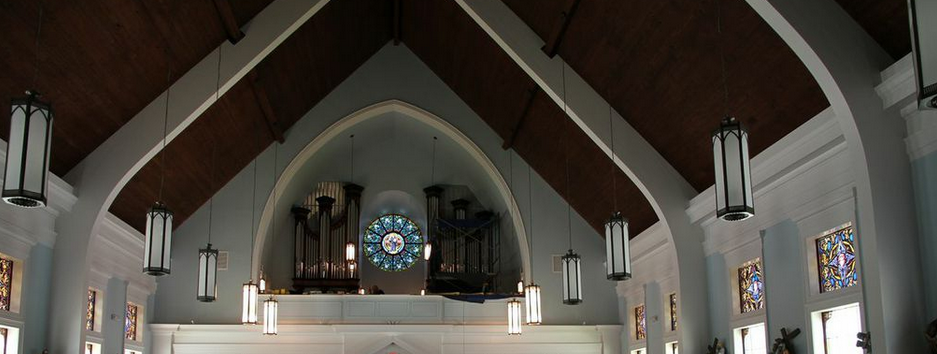________________________________
1. A parishioner sends us the following news from Chesapeake, Virginia:Saint Benedict's Parish, in Chesapeake, VA will celebrate the Feast of the Immaculate Heart of Mary this evening with the Blessing of our new Pipe Organ and a Solemn High Mass in honor of Our Lady's Immaculate Heart. This new organ complements our new Church (first church built from the ground-up for the Extraordinary Form of the Roman rite in the U.S. since the issuance of Summorum Pontificum) that was blessed on 5 March 2011, and is now paid off, and will soon be consecrated.
St. Benedict's Parish comprises 220 families, and is honored to claim four current seminarians and one ordained FSSP priest. Two of our seminarians are transitional deacons and will be ordained next year -- one of which will assist at the high altar at this evening's Solemn High Mass. (Photographs by Deborah P. Spidle)
Congratulations to this wonderful congregation and their faithful priests!
________________________________
2. The other brand-new organ is in a Very, Very Special Place (the first image is from there):
JERUSALEM – Summer 2014. Whoever walks inside the Church of the Holy Sepulchre, and proceeds towards the Latin chapel, notices at once a new musical instrument fixed against the wall of the Franciscan Chapel of the Column. It is the new organ which from now on will be used by Father Armando Pierucci, organist of the Holy Sepulchre and of the Magnificat Institute, to accompany liturgical celebrations.
Fr Armando, can you quickly introduce yourself ?
I am Armando Pierucci, a Franciscan friar born in Italy on September 2nd, 1935, succeeding the former organist of the Holy Sepulchre, Augustin Lama, who died in 1988. I am however not worthy to be the successor of this illustrious Palestinian musician, who was the organist of the Holy Sepulchre for 68 years (between 1920 and 1988)!
Why was it necessary to change the organ in your opinion ?
There are many reasons. First, we badly need this organ, next to the Chapel of the Holy Sacrament, in order to accompany the crowd of faithful and the choir during celebrations. On the other hand, the old organ had become very old, with many hitches. For instance, the old organ had 35 different ranks of pipes, but at the end only five were operational.
The new organ is obviously smaller in size, with 13 ranks of pipes, and that serves the purpose. It is not an organ which will be used for concerts (or to make noise, according to other communities point of view)! In any case, the new organ will be ready for use at the end of next September.
Who launched the idea, and how did the project come about ?
It was my idea, the organist who uses the organ. I had talked to the [Franciscan] Custodian [of the Holy Land], Fr Pierbattista Pizzaballa, who said that we should find a donor. When the Franciscan donor of the big organ heard of that, he felt a bit annoyed because we did not turn to him; yet he promised to find donors. This Franciscan is Fr Stanislao Bertagnoli, an 85-year-old Austrian. He started sending out letters to everybody asking for potential donors. What seemed amazing was that Fr Stanislao comes from [a region in] Southern Austria, where people speak a dialect that no German speakers, or Italian speakers, would understand. People laughed while listening to him speak, but later gave him what he wanted !
When did the Franciscans get the right to play organ music inside the Church of the Holy Sepulchre?
Each co-owning community has the right to do what it likes within its own compound. From our side, and since mid-17th-century, we had installed a small organ, a harmonium, to be used in the Franciscan-owned compound. In the beginning, that had brought about many protests from the Greek Orthodox.
We see as well inside the Holy Sepulchre another organ, a bigger one, which is kept upstairs in the gallery [see above]. Does this organ require renovation ?
It is the organ which was installed in 1982. It is relatively new, and needs maintenance off and on. However, doves at times try to sneak inside the pipes, which compelled us to install a sort of a tent or cover on top
Interview by Firas Abedrabbo



